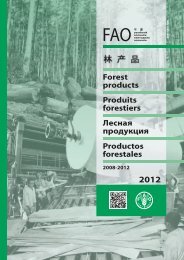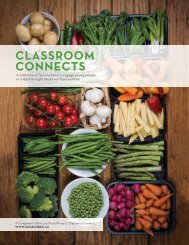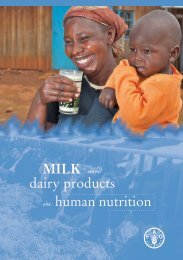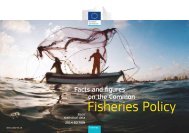Create successful ePaper yourself
Turn your PDF publications into a flip-book with our unique Google optimized e-Paper software.
XIX<br />
FAO YEARBOOK OF FOREST PRODUCTS<br />
INTRODUCTION<br />
This is the 66 th<br />
issue of the FAO Yearbook of Forest<br />
Products. The yearbook contains annual data on the production<br />
and trade in forest products for the years 2008-2012 and on<br />
direction of trade in 2011 and 2012. The full forest products time<br />
series starting in 1961 is available in electronic form on compact<br />
disk (FAOSTAT CD) and on the Internet at:<br />
http://www.fao.org/forestry/statistics. For information on acquiring<br />
any of these information products, contact: publicationssales@fao.org.<br />
The publication of the yearbook is made possible by the<br />
cooperation of governments which supply most of the information<br />
in the form of replies to questionnaires. This edition benefits from<br />
expanded co-operation in gathering forest sector statistics<br />
among a number of the international organizations. Beginning in<br />
1999, information for production and trade in 1998 and updates<br />
for 1997 were gathered using a joint forest products<br />
questionnaire supported by the Forestry Department of FAO, the<br />
United Nations Economic Commission for Europe (UNECE), the<br />
Statistical Office of the European Union (Eurostat) and the<br />
International Tropical Timber Organization (ITTO). This joint<br />
questionnaire is in response to requests from member countries<br />
of all four partner organizations to rationalise our approaches to<br />
forest sector data collection and dissemination. It is hoped that<br />
this will reduce the reporting burden on countries, improve<br />
response rates and increase consistency among forestry<br />
statistical publications issued by the various agencies.<br />
The yearbook tables are arranged in three parts. The first<br />
part contains information about the most important countries in<br />
terms of production, consumption and trade of forest products in<br />
2012. The second part contains the main tables reporting the<br />
volume of production, consumption and trade, as well as total<br />
and unit values of trade, for every country and type of forest<br />
product. The third part contains tables showing the bilateral<br />
directions of trade for major product categories.<br />
The tables in the second part present data for the 5 years<br />
2008-2012. These tables have been arranged so that, for any<br />
forest product, the tables showing data on production, imports<br />
and exports of that product follow one another. Because the<br />
product subdivisions used in production and trade statistics<br />
differ, the series for certain product categories include only<br />
production statistics and for certain others only trade statistics. In<br />
general, tables for roundwood are followed by those for<br />
sawnwood, panel products, pulp and paper, in that order. Within<br />
these groupings, tables showing the total for all products within<br />
the group come first, followed by tables for each of the individual<br />
products.<br />
The direction of trade tables show the 15 largest exporters<br />
and 25 largest importers for each of a number of widely traded<br />
forest products. This information, reported for the latest two<br />
years, is based on an analysis of data provided by countries<br />
through the joint questionnaire and from data drawn from the<br />
COMTRADE database of the United Nations Statistics Division.<br />
As part of FAO’s effort to expand its statistical coverage, more<br />
comprehensive direction of trade statistics for countries will also<br />
shortly be released in electronic form on the FAOSTAT Internet<br />
website.<br />
Forest products and forest product aggregates are defined<br />
briefly below. In this section, the forest product aggregates and<br />
individual forest products are listed in the order in which they<br />
occur in the yearbook. These definitions are based on those<br />
contained in: Classification and definitions of forest products,<br />
FAO, Rome, 1982. Some refinement of product definitions and<br />
classifications have been made in this issue in order to meet the<br />
needs of all partners of the joint forest products questionnaire<br />
and to avoid possible double-counting in some forest product<br />
categories. A table is included at the end of this section which<br />
shows the composition of product aggregates in production,<br />
consumption and trade. In the case of exports and imports, a<br />
table is provided at the end of this section that associates the<br />
forest product name with the relevant numerical codes used in<br />
the United Nations Standard International Trade Classification<br />
(SITC) system and in the Harmonised System (HS) of the World<br />
Customs Organization.<br />
The tables are extracted from FAO’s FAOSTAT database on<br />
forest products. As such, the tables use computer-generated<br />
labels for forest product names and to represent geographic<br />
entities. A listing of the computer generated labels for names of<br />
continents, countries and areas is displayed in a table towards<br />
the end of this section.<br />
As in previous issues, this yearbook includes estimates<br />
made by FAO and data obtained from sources other than the<br />
official replies to questionnaires. The 5-year series incorporates<br />
both official revisions and new information from other sources.<br />
Thus, the figures published in earlier issues may have been<br />
revised during the preparation of these series. In certain cases,<br />
the data provided by countries are stated in different units or<br />
systems of measurement from those used in the yearbook. For<br />
presentation in the yearbook it has been necessary to convert to<br />
a standard set of metric units. The coefficients used for<br />
conversion to the metric system are shown in a table at the end<br />
of this section. It is hoped that countries will re-examine the<br />
estimates and provide FAO with more accurate figures when<br />
these appear to be wrong.<br />
One of the areas where statistics are not reported very<br />
often by countries is wood fuel. So, for many countries, FAO<br />
must estimate wood fuel production. Recently, FAO revised<br />
the complete series of wood fuel production figures back to<br />
1961, based on a new model of wood fuel consumption in<br />
countries that is believed to produce more reliable estimates.<br />
In some countries, these new estimates vary greatly from<br />
those that were produced before.<br />
A table of exchange rates for the 5 years of the data series is<br />
also included in the yearbook. This table shows the exchange<br />
rates used to convert local currency units to a common currency<br />
(US$) in the trade value tables. Data for production and trade<br />
are rounded to the nearest 1 000 units; volume figures (including<br />
apparent net consumption per thousand capita) are in metric<br />
tons for charcoal, pulp and paper products and cubic meters for<br />
all other products. When the name of a country or area is given<br />
without a corresponding numerical entry or printed as "0", it<br />
means that quantities are less than 500 units. Entries of less<br />
than 500 go into the regional total and world total even though<br />
they are not shown at the country level.<br />
To improve these series, readers are encouraged to contact<br />
FAO if they find data that is inconsistent with recognised or<br />
authoritative data sources or if any of the data does not appear to<br />
make sense, even if it has come from an official source. FAO<br />
wants to report accurate and timely data and seeks the<br />
assistance of all countries to improve the compilation and<br />
dissemination of high quality statistics on forest product<br />
production and international trade. The contact details for FAO<br />
staff dealing with each of the sections of the yearbook are given<br />
below. Forest Economics, Policy and Products Division, FAO<br />
Forestry Department, Viale delle Terme di Caracalla, 00153<br />
Rome, Italy. Fax: +39-06-57055137 or +39-06-57053945; E-mail:<br />
for general comments – FPS@fao.org; production statistics –<br />
Mauro.Paolozzi@fao.org; trade statistics –<br />
Roberto.Bargigia@fao.org.







